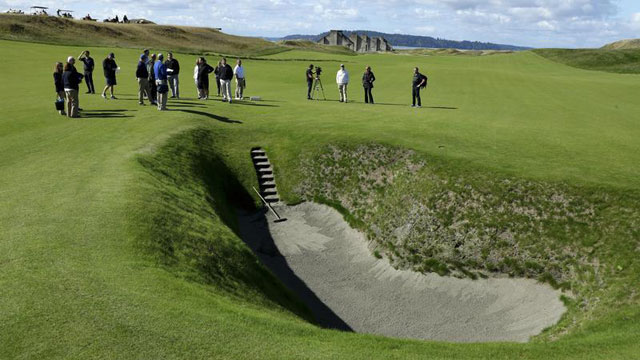NEWS
Chambers Bay ready for world to see its unique layout at US Open

UNIVERSITY PLACE, Wash. (AP) — For the students at the nearby high school, it was simply known as the "Sand Pit," the landmark two miles down the road where they would run as part of gym class.
For the passengers on the train between Seattle and Portland, Oregon, it was a moment to look out the other windows of the train car and take in the waters of Puget Sound. Looking the opposite direction meant staring into the teeth of the ugly old gravel and sand quarry hugging the shoreline.
A decade ago, that was the property now known as Chambers Bay. It was sand, and gravel and old concrete pilings. An eyesore. That's when the metamorphosis began, and it transformed from a sandy blemish into a swath of greenery cut through man-made mounds and dunes unique to American golf and, specifically, the Pacific Northwest.
Now the close-up for Chambers Bay has arrived: The 2015 U.S. Open, a rare occasion where the golf course is getting more attention than the players.
"It will be everything I know about the game being realized," course designer Robert Trent Jones Jr. said. "These were dreams and very, very hard work to craft the great green stage upon which the dream will be fulfilled. That's the reality. It's no longer a dream."
Chambers Bay is a reclamation project for the land on which it sits and for golf in the Pacific Northwest, a segment of the United States that is infrequently visited by championship golf.
Looking for green, lush, tree-lined fairways the width of a hallway with emerald foliage? Head up the road about an hour to Sahalee Country Club, the host of the 1998 PGA Championship. This is the antithesis of the stereotype for a golf course in this corner of the country.
Chambers Bay was built as the opposite of traditional, from the way it was constructed, to the funding behind the project, to the type of grass used on every fairway and green. The course was a risk of political and financial capital. It's about to have its biggest payoff, with a worldwide audience tuning in to see the fescue grass fairways and greens, the undulating, rolling putting surfaces and the brown-hued sand dunes all with the backdrop of Puget Sound water, the Olympic Mountains and bald eagles flying overhead.
When the first group tees off Thursday morning, Chambers Bay will become the youngest golf course to host the U.S. Open since Hazeltine — constructed by Jones' father — in 1970.
The creation of Chambers Bay was championed by then Pierce County Executive John Ladenburg, who decided the former gravel and sand quarry should be purchased by the county and use $21 million for its construction. From the beginning, Ladenburg demanded a golf course that was unique. Part of the reason Jones and his firm was chosen was their ambition, including the tag "Chambers Creek, home of the 2030 U.S. Open," in their presentations to the county.
Thanks to Winged Foot withdrawing its bid to host the 2015 Open, that audacious goal was off by 15 years.
The golf course was built hand-in-hand with input from the USGA, which had on-site influence throughout construction. Put a path there for spectator movement. Flatten the tops of the dunes so tents and grandstands may be easily erected. Keep the concrete pilings along the 18th — someday they might be perfect for corporate suites.
The U.S. Open was always the goal. Even what seemed like minor decisions proved vital in having a winning bid. When more money could have been put into providing a clubhouse with grandeur overlooking the 930 acres of the golf course and neighboring public spaces, as an example, Ladenburg and county staff insisted the funds be used for features that mattered to course.
"Every time (Ladenburg) was given a choice between that and a better commercial result, meaning money, he made the right decision," Jones said.
Among the unique aspects of Chambers Bay is the lack of the trouble found on other American courses. There are no vertical hazards on the golf course, or trouble with water. The one tree, Lone Fir, sits stoically next to the 16th tee. Jones and his group put the defense of the course in the sandy waste areas and mounded, rolling green complexes that will likely cause grumbles.
"Right away it looks benign. It seems benign. So what we did is invest the defense of the course in and around the green complexes. That's the heart of the golf course," Jones said. "The pulsing blood, flowing place where half the strokes in the game, in a par round, are expected to be made on the greens or on and around the greens. They're strongly contoured. They're lightning fast. You can't even tell where the fairway begins and the green starts."
The course has changed through its brief history. The 2010 U.S. Amateur served as a laboratory to see how it would react to tournament conditions. Teeing grounds were added. Landing areas were softened. Greens were reconstructed to accept shots from longer clubs. The entire seventh green was lowered and moved forward after the amateur to be more forgiving. Jones and his team even went so far as to roll basketballs on the reconstructed green to make sure good shots were rewarded and not penalized.
Those changes and the versatility of the course will be on full display during the championship. Some will still remember their first impressions of the site when it was just a giant sandbox.
"Taking a look over this fence at the property, and at that point it was just piles of sand, remnants of this old gravel and sand mine," USGA executive director Mike Davis said. "To think about where it is today, it's fun to look back at how it happened so quickly."